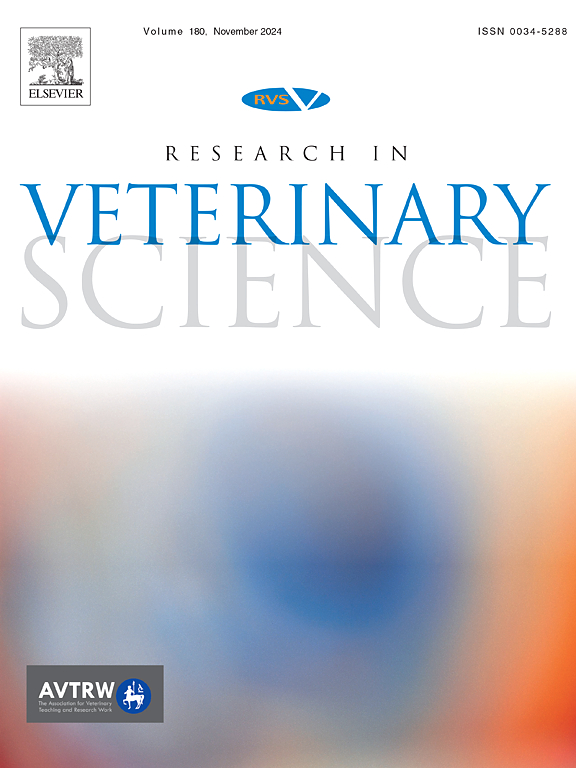犬口腔病原菌种类的评估:抗真菌敏感性和对人类健康的影响。
IF 2.2
3区 农林科学
Q1 VETERINARY SCIENCES
引用次数: 0
摘要
伴侣的动物有可能向其主人传播机会性疾病,包括由居住在其口腔微生物群中的念珠菌属酵母菌引起的疾病。本研究旨在从犬口腔中分离和鉴定酵母,并评估其对抗真菌药物的敏感性。采用MALDI-TOF-MS和VITEK 2自动方法对50只犬(年龄2-4岁,不同品种)的酵母菌进行鉴定。以白色念珠菌(37.5%)和假丝酵母菌(25%)为主,其次为haemuloni念珠菌、热带念珠菌、krusei念珠菌和asahii Trichosporon(12.5%)。在这项研究中,抗真菌药敏试验显示一般的敏感性和有限的耐药性。虽然大多数抗真菌药物表现出良好的疗效,但一些念珠菌菌株对氟康唑(FLC)、caspofungin (CAS)和两性霉素B (AMPB)表现出耐药性。这些发现强调了进行真菌培养和抗真菌谱测试对有效管理人类和动物真菌感染的重要性。因此,警惕的监测和控制措施对于减少机会性疾病从宠物传播给人类至关重要。本文章由计算机程序翻译,如有差异,请以英文原文为准。
Assessment of pathogenic yeast species in the oral cavity of dogs: Antifungal susceptibility and implications for human health
Companions' animals can present a risk for the transmission of opportunistic diseases to their owners, including those caused by yeasts of the Candida genus residing in their oral microbiota. This study aimed to isolate and identify yeasts from the oral cavity of dogs and assess their susceptibility to antifungals. Yeast species were identified using automated methods MALDI-TOF-MS and VITEK 2 from 50 dogs (aged 2–4 years, various breeds). Among the evaluated animals Candida albicans (37.5 %) and Candida parapsilosis (25 %) were predominant, followed by other species including C. haemuloni, C. tropicalis, C. krusei, and Trichosporon asahii (12.5 % each). In this study, antifungal susceptibility testing revealed a general susceptibility with limited resistance. Although most antifungals exhibited good efficacy, some Candida strains demonstrated resistance to fluconazole (FLC), caspofungin (CAS), and amphotericin B (AMP![]() B). These findings highlight the importance of conducting fungal cultures and antifungigram testing for the effective management of fungal infections in humans and animals. Therefore, vigilant monitoring and control measures are essential to reduce the transmission of opportunistic diseases from pets to humans.
B). These findings highlight the importance of conducting fungal cultures and antifungigram testing for the effective management of fungal infections in humans and animals. Therefore, vigilant monitoring and control measures are essential to reduce the transmission of opportunistic diseases from pets to humans.
求助全文
通过发布文献求助,成功后即可免费获取论文全文。
去求助
来源期刊

Research in veterinary science
农林科学-兽医学
CiteScore
4.40
自引率
4.20%
发文量
312
审稿时长
75 days
期刊介绍:
Research in Veterinary Science is an International multi-disciplinary journal publishing original articles, reviews and short communications of a high scientific and ethical standard in all aspects of veterinary and biomedical research.
The primary aim of the journal is to inform veterinary and biomedical scientists of significant advances in veterinary and related research through prompt publication and dissemination. Secondly, the journal aims to provide a general multi-disciplinary forum for discussion and debate of news and issues concerning veterinary science. Thirdly, to promote the dissemination of knowledge to a broader range of professions, globally.
High quality papers on all species of animals are considered, particularly those considered to be of high scientific importance and originality, and with interdisciplinary interest. The journal encourages papers providing results that have clear implications for understanding disease pathogenesis and for the development of control measures or treatments, as well as those dealing with a comparative biomedical approach, which represents a substantial improvement to animal and human health.
Studies without a robust scientific hypothesis or that are preliminary, or of weak originality, as well as negative results, are not appropriate for the journal. Furthermore, observational approaches, case studies or field reports lacking an advancement in general knowledge do not fall within the scope of the journal.
 求助内容:
求助内容: 应助结果提醒方式:
应助结果提醒方式:


